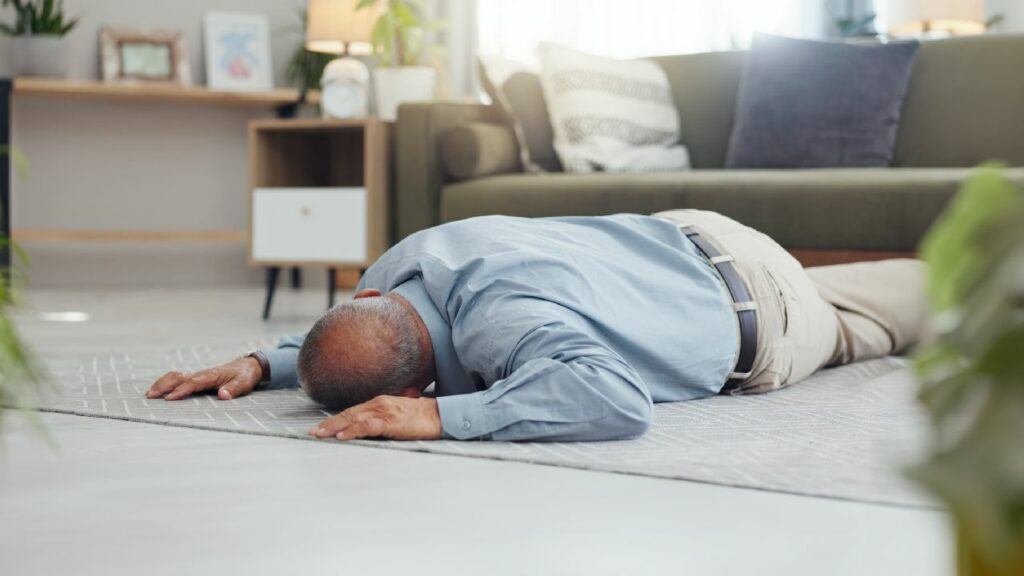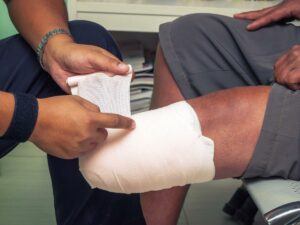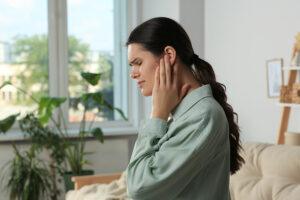The world dissolved into a tunnel of swirling colours. My ears whooshed, a frantic drum solo against the dimming roar of the crowd. My legs, like jelly, buckled.
Then, darkness.
You may feel like you just read a Hollywood script, but for some, fainting can be a frightening and traumatic experience. In these moments, first aid for fainting is critically important.
Immediate first aid treatment for fainting
- Safety first – remove any hazards from the scene
- Check for responsiveness – gently tap person and ask if they are okay
- Call for help – if unresponsive or breathing irregularly, call 000
- Position for recovery – lay flat on back on a stable surface
- Elevate legs – prop legs up with an object if possible
- Fresh air – open windows and doors, loosen clothing
- Assess for further injuries – check for any swelling or bleeding, particularly of the head
- Monitor recovery – stay with the person and monitor their condition
For an in-depth guide to first aid treatment for fainting, click here.
The Vital Facts
- Up to 35% of the population will have at least one faint during their lifetime
- In Australia, fainting is the fifth most common cause of hospitalisation
Source: Medtronic
Explore this article
What can cause fainting?
Fainting, also known as syncope, is often triggered by a dip in blood flow to the brain. A brief loss of consciousness can occur from emotional stress, standing too quickly, dehydration, and low blood sugar. Heart issues, seizures, and medications can also play a role.
What are the signs and symptoms that someone is about to faint?
There are several warning signs that indicate someone is about to faint.
It’s important to remember that not everyone experiences all these signs, and some people may faint without any warning at all.
If you notice someone exhibiting several of these symptoms, it’s best to act quickly to help them avoid fainting or injury from a fall.
Feeling lightheaded or dizzy
This is a common warning sign. A woozy sensation that the world is spinning or tilting.
Weakness
A general feeling of weakness or fatigue can set in, making it difficult to stand or hold things.
Nausea
An unsettled stomach or nausea can accompany the lightheadedness, adding to the feeling of unease.
Vision changes
Blurred vision, seeing spots, or even temporary tunnel vision can occur as blood flow to the brain weakens.
When looking at a person who is about to faint, their eyes may appear ‘vacant’.
Sweating
Cold, clammy sweat might break out as the body tries to regulate itself.
Paleness
The person’s face might become noticeably pale as blood flow diminishes.
Tingling or numbness
Tingling or numbness in the fingers or around the lips can sometimes happen.
First Aid for Fainting – Steps
1. Safety first
Ensure the scene is safe from hazards where the person might fall further. If they’ve already fainted, gently lower them to the ground if they’re not already lying down.
2. Check responsiveness
Gently tap the person and ask loudly if they’re okay. If they don’t respond, place the person on their side and follow the DRSABCD.
3. Call for help
If they’re unresponsive or breathing abnormally, call emergency services immediately.
If the person is not breathing or does not have a pulse, call emergency services and begin CPR.
In most fainting cases, this won’t be necessary, and you can proceed to step 4.
4. Position for recovery
If they are conscious but pale and dizzy, lay them flat on their back on a stable surface. Loosen any tight clothing around the neck or waist.
5. Elevate legs
If possible, if they are laying flat on their back, elevate their legs slightly by propping them up on a bag, chair, or other object. This helps blood flow return to the brain.
6. Fresh air
Open windows or doors, or loosen clothing to increase airflow.
If the fainting episode was brought upon by heat it’s important to loosen necessary clothing and cool the person down by fanning them or wiping them with a wet cloth.
7. Assess for further injuries
It’s important to assess a person who has fainted for injuries that can be caused by the fall.
A fall can result in bumps, cuts, or even more serious head injuries. Check for any bleeding or swelling on the head and for signs of confusion, dizziness, or difficulty speaking after they regain consciousness.
Cuts and scrapes are common from falls on hard surfaces like pavement or tile. Assess for any bleeding and clean and dress minor wounds as needed.
Sprains, strains or even broken bones can occur from a fall, especially in older adults or people with weakened bones. Look for severe pain, swelling, difficulty moving affected joins or inability to bear weight on injured limbs.
8. Monitor recovery
Stay with the person and monitor their condition. Once they feel suitably recovered, assist them to stand up, and have a chair nearby in case they fall again.
Offer them sips of cool water once they’re fully alert.
Learning First Aid is VITAL
Don’t panic – be prepared! Our courses understand the importance of first aid for fainting, as well as other applications, providing you with the knowledge and skills to act decisively in emergencies.






